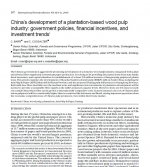China’s Development of a Plantation-based Wood Pulp Industry
Government Policies, Financial Incentives, and Investment Trends
By Chris Barr , Christian Cossalter - World Agroforestry Centre, CIFOR, Forest Trends View PublicationThe Chinese government is aggressively promoting development of a domestic wood pulp industry, integrated with a plantation-based fiber supply and downstream paper production. It is doing so by providing discounted loans from state banks, fiscal incentives, and capital subsidies for establishment of at least 5.8 million hectares of fast-growing pulpwood plantations. This article examines the development of bleached hardwood kraft pulp (BHKP) mills in South China, including the Asia Pulp & Paper (APP) Jinhai mill in Hainan Province and the proposed Fuxing pulp mill project in Guangdong Province. Both mills face fiber shortfalls over the medium term, and significant new investments in plantation development will be needed to provide a sustainable fiber supply at the mills’ projected capacity levels. However, there are few sites in southern coastal China where fiber can be grown at internationally competitive costs. In most instances, the cost of Chinese plantation pulpwood will be considerably higher than in countries like Indonesia and Brazil, raising important questions about the economic competitiveness of Chinese pulp producers even within their home market.

